- What is Feijoa?
- Feijoa: A Unique Fruit with a Distinct Flavor
- Appearance
- Cultivation
- Health Benefits
- Uses
- Growing Feijoa
- 1. Climate and Temperature
- 2. Soil and Location
- 3. Planting
- 4. Watering and Fertilizing
- 5. Pruning
- 6. Harvesting
- 7. Pest and Disease Control
- Choosing the Right Location for Feijoa Trees
- Climate Requirements
- Sunlight
- Soil Type
- Wind Protection
- Space
- Conclusion
- Planting Feijoa Trees: Tips and Techniques
- 1. Choose the Right Location
- 2. Prepare the Soil
- 3. Planting
- 4. Mulching
- 5. Pruning
- 6. Watering and Fertilizing
- 7. Harvesting
- Caring for Feijoa Trees
- 1. Planting
- 2. Watering
- 3. Fertilizing
- 4. Pruning
- 5. Pest and Disease Control
- 6. Harvesting
- Watering and Fertilizing Feijoa Trees
- Watering
- Fertilizing
- Pruning Feijoa Trees: Best Practices
- 1. Timing
- 2. Tools
- 3. Removing Dead and Diseased Wood
- 4. Thinning
- 5. Shaping
- 6. Pruning Young Trees
- 7. Regular Maintenance Pruning
- 8. Renovation Pruning
- 9. Disinfection
- Health Benefits of Feijoa
- 1. High in Vitamin C
- 2. Rich in Dietary Fiber
- 3. Packed with Antioxidants
- 4. Supports Cardiovascular Health
- 5. Boosts Brain Function
- 6. Supports Weight Management
- 7. Good for Eye Health
- Feijoa: Packed with Vitamins and Antioxidants
- Vitamins
- Antioxidants
- Other Nutrients
- Q&A:
- What is feijoa?
- How do you grow feijoa?
- What are the health benefits of feijoa?
- Can you eat feijoa skin?
- When is the best time to harvest feijoa?
- What are some popular recipes that use feijoa?
- Can I grow feijoa in a container?
- Video: TOP 5 Anti-Aging Fruits You Should Be Eating Every Day!
Feijoa, also known as pineapple guava, is a small fruit that is native to South America. It has a unique flavor that is often described as a combination of pineapple, guava, and mint. Feijoa is a popular fruit in many countries, and it is becoming increasingly popular in other parts of the world due to its many health benefits.
Feijoa is a rich source of vitamin C, vitamin E, and dietary fiber. Vitamin C is an essential nutrient that plays a crucial role in the immune system, while vitamin E is a powerful antioxidant that helps protect cells from damage. Dietary fiber, on the other hand, promotes healthy digestion and can help prevent constipation.
In addition to its high vitamin and fiber content, feijoa is also a good source of potassium, magnesium, and manganese. These minerals are important for maintaining normal blood pressure, promoting healthy bones, and supporting the body’s energy production.
Feijoa is also known for its antimicrobial properties, which can help boost the immune system and protect against infections. Studies have shown that feijoa extract has antimicrobial activity against a wide variety of bacteria and fungi, including those that cause foodborne illnesses and skin infections.
Growing feijoa is relatively easy, as the plant is adaptable to a wide range of soils and climates. It thrives in temperate regions with mild winters and moderate summers. Feijoa trees can be grown from seeds or cuttings, and they typically start producing fruit within 2-3 years.
Overall, feijoa is a delicious and nutritious fruit that offers a wide range of health benefits. Whether you enjoy it fresh, in smoothies, or as part of a recipe, adding feijoa to your diet is a great way to boost your intake of essential vitamins and minerals.
What is Feijoa?
Feijoa, also known as pineapple guava, is a fruit native to South America. It is botanically classified as Acca sellowiana and belongs to the Myrtaceae family. The fruit has a green or pale green exterior and a unique flavor that is a combination of pineapple, guava, and strawberry. Feijoa is highly aromatic and has a granular, jelly-like texture when ripe.
This fruit is commonly cultivated in countries with a subtropical climate, such as New Zealand, Australia, and parts of South America. It is also grown in some regions of the United States, including California and Hawaii. Feijoa is a popular fruit due to its delicious taste and numerous health benefits.
Feijoa is rich in vitamins and minerals, including vitamin C, vitamin E, potassium, and dietary fiber. It is also a good source of antioxidants, which help protect the body against free radicals. The fruit is low in calories and contains no cholesterol or saturated fat, making it a healthy choice for those watching their weight or wanting to improve their overall health.
Feijoa can be eaten fresh or used in various culinary preparations. It is commonly added to fruit salads, smoothies, desserts, and baked goods. Feijoa can also be made into jams, jellies, and sauces. Additionally, it is used in the production of alcoholic beverages, such as liqueurs and wines. The unique flavor of Feijoa adds a tropical twist to any dish or drink it is used in.
| Scientific Name | Acca sellowiana |
| Family | Myrtaceae |
| Native to | South America |
| Flavor | Pineapple, guava, strawberry |
| Common Cultivation Areas | New Zealand, Australia, South America, California, Hawaii |
| Key Nutrients | Vitamin C, vitamin E, potassium, dietary fiber |
| Uses | Fresh consumption, fruit salads, smoothies, desserts, baked goods, jams, jellies, sauces, alcoholic beverages |
Feijoa: A Unique Fruit with a Distinct Flavor
Feijoa, also known as pineapple guava, is a unique fruit that is native to South America. It is widely cultivated in countries like Brazil, Argentina, and Uruguay. Feijoa has a distinct flavor that is often described as a combination of pineapple, guava, and strawberry.
Appearance
Feijoa is a small fruit that is usually green in color. It has a thin, edible skin that is slightly rough to the touch. The fruit is oval or egg-shaped, and it ranges in size from 2 to 4 inches in length. Inside, the fruit is filled with a jelly-like flesh that is typically cream-colored.
Cultivation
Feijoa plants are evergreen shrubs that can grow up to 15 feet in height. They prefer temperate climates and are typically grown in regions with mild winters and moderate summers. Feijoa plants require well-drained soil and full sun to thrive.
- Feijoa trees produce fragrant flowers in the spring, which are a favorite of bees.
- The fruit is typically harvested in the fall.
- Feijoa plants are known for their hardiness and ability to withstand drought conditions.
Health Benefits
Feijoa is not only delicious, but it also offers several health benefits:
- High in antioxidants: Feijoa is rich in antioxidants, which help protect the body against damage from harmful free radicals.
- Good source of vitamins and minerals: Feijoa is packed with vitamin C, vitamin E, and dietary fiber.
- Boosts immune system: The high vitamin C content in feijoa helps strengthen the immune system, making it an excellent fruit to consume during cold and flu season.
- Improves digestion: Feijoa is a good source of dietary fiber, which aids in digestion and helps prevent constipation.
Uses
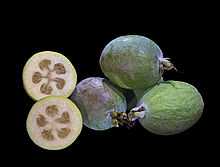
Feijoa can be enjoyed in a variety of ways:
- Raw: The fruit can be eaten raw, scooping out the flesh with a spoon.
- Cooked: Feijoa can be used in pies, crumbles, and other baked goods.
- Juice: The fruit can be juiced to make a refreshing beverage.
- Jam: Feijoa jam is a popular spread that can be enjoyed on toast or in desserts.
| Nutritional Information | Per 100g |
|---|---|
| Calories | 55 |
| Carbohydrates | 14g |
| Fiber | 6g |
| Vitamin C | 33% of RDI |
| Vitamin E | 10% of RDI |
Growing Feijoa
Feijoa is a delicious and nutritious fruit that can be grown in your own backyard. Here are some tips to help you successfully grow feijoa:
1. Climate and Temperature
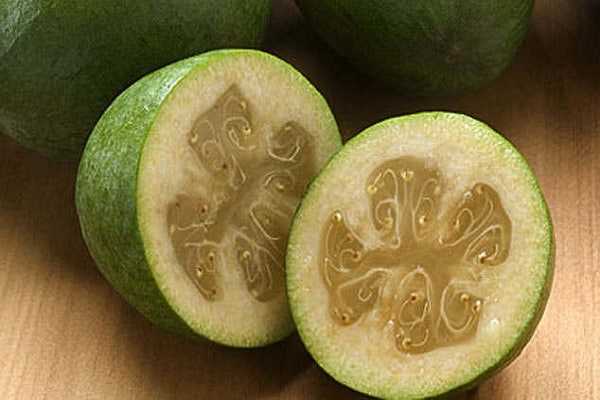
Feijoa is native to South America and thrives in a subtropical climate. It can tolerate temperatures as low as 15°F (-9°C) and as high as 100°F (38°C). However, it is best to plant feijoa in an area with mild winters and moderate summers.
2. Soil and Location
Feijoa prefers well-draining soil that is slightly acidic to neutral (pH 5.5-7.5). It can handle a range of soil types as long as they are not waterlogged. Choose a sunny spot in your garden with good air circulation to plant your feijoa tree.
3. Planting
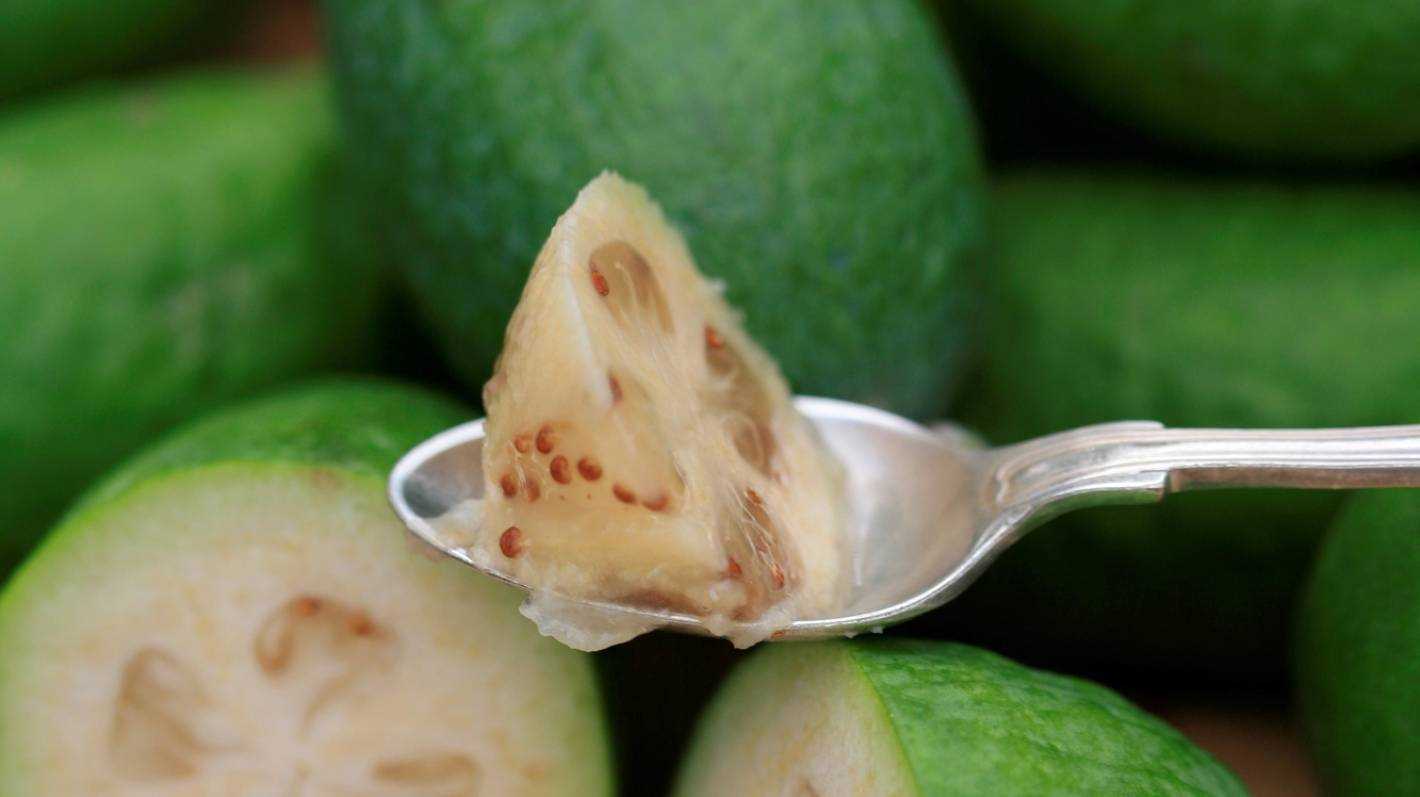
Feijoa can be grown from seeds or propagated from cuttings. If you choose to grow from seeds, soak them in water for 24 hours before planting. Dig a hole that is large enough to accommodate the root system of the feijoa tree and place it in the hole, making sure the soil is firm around the roots.
4. Watering and Fertilizing
Feijoa trees should be watered regularly, especially during dry spells. However, be careful not to overwater as it can lead to root rot. Fertilize your feijoa tree with a balanced fertilizer in early spring and early summer to promote healthy growth.
5. Pruning
Pruning feijoa trees is important to maintain their shape and promote fruit production. Prune any dead or damaged branches, as well as any branches that are crossing or rubbing against each other. Pruning should be done in late winter or early spring before new growth begins.
6. Harvesting
Feijoa fruits are ready to be harvested when they start to drop from the tree or have a slight yield when gently squeezed. They should have a fragrant aroma. Harvest the fruits by gently twisting and pulling them from the branch. Feijoa fruits do not ripen off the tree, so they should be eaten or used immediately.
7. Pest and Disease Control
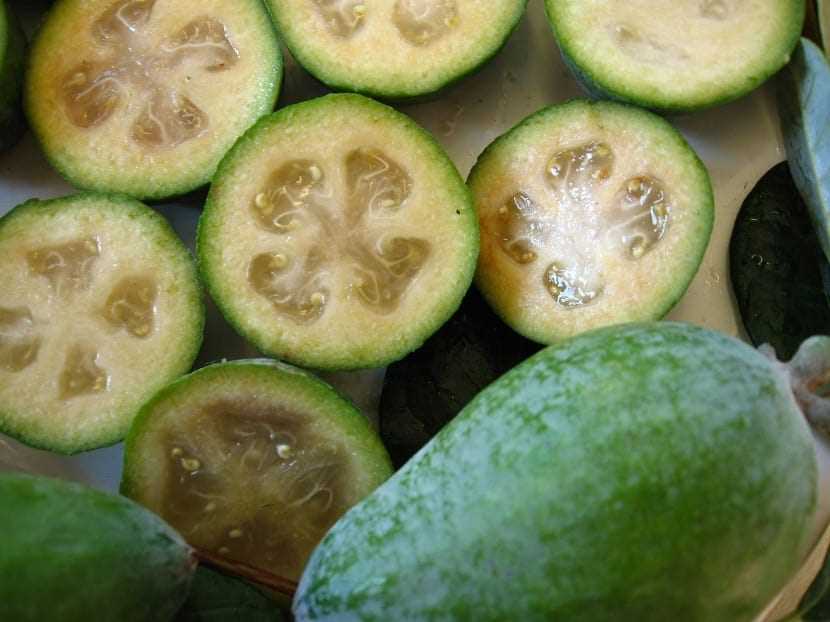
Feijoa trees are generally resistant to many pests and diseases. However, they can be susceptible to fruit flies, scale insects, and fungal diseases. Monitor your tree regularly and take appropriate measures if you notice any signs of pests or diseases.
By following these tips, you can enjoy the pleasure of growing your own feijoa tree and harvesting its delicious fruits.
Choosing the Right Location for Feijoa Trees
Feijoa trees (Acca sellowiana) are native to South America and are known for their delicious fruit and beautiful flowers. When planting feijoa trees, it is important to choose the right location to ensure their health and productivity.
Climate Requirements
Feijoa trees thrive in warm temperate and subtropical climates. They prefer regions with mild winters and long, warm summers. The optimal temperature range for feijoa trees is between 50°F (10°C) and 80°F (27°C). Additionally, they require a minimum of 50 frost-free days to develop fruit properly.
Sunlight
Feijoa trees require full sun to thrive and produce high-quality fruit. Choose a location that receives at least 6-8 hours of direct sunlight daily. Without enough sunlight, the tree may become weak, and the fruit production may be reduced.
Soil Type
Feijoa trees prefer well-draining soil with a pH level between 5.5 and 7.5. They do best in loamy soil that is rich in organic matter. Avoid heavy clay soils, as they can retain too much moisture and lead to root rot. If your soil is clayey, consider amending it with sand or organic matter to improve drainage.
Wind Protection
Feijoa trees are somewhat sensitive to wind. Choose a location that offers some protection from strong winds, such as a fence or building. This will prevent the tree from being damaged and help maintain its shape.
Space
Feijoa trees can grow up to 15-20 feet (4.5-6 meters) in height and spread. When choosing a location, make sure there is enough space for the tree to grow to its full size without being crowded by other plants or structures. Giving the tree enough space will also ensure good air circulation and reduce the risk of fungal diseases.
Conclusion
Choosing the right location is crucial for the successful growth of feijoa trees. Consider the climate requirements, sunlight, soil type, wind protection, and space when selecting a spot for planting. By providing the appropriate conditions, you can enjoy healthy feijoa trees and a bountiful harvest of delicious fruits.
Planting Feijoa Trees: Tips and Techniques
Feijoa trees, also known as pineapple guava, are a popular fruit tree that is native to South America. They are hardy, evergreen trees that can grow in a variety of climates. Here are some helpful tips and techniques for planting feijoa trees:
1. Choose the Right Location
- Feijoa trees prefer well-drained soil that is slightly acidic.
- They need full sun to produce the best fruit, so choose a location that receives at least 6 hours of direct sunlight per day.
- Ensure there is enough space for the tree to grow, as feijoa trees can reach a height of 10 to 15 feet and spread out to 10 feet.
2. Prepare the Soil
- Before planting, loosen the soil to a depth of about 12 inches and remove any weeds or grass from the area.
- Consider adding organic matter, such as compost or well-rotted manure, to improve soil fertility and drainage.
3. Planting
- Dig a hole that is twice as wide and deep as the feijoa tree’s root ball.
- Gently remove the tree from its container and place it in the hole, making sure that the top of the root ball is level with the ground.
- Backfill the hole with soil, firming it gently to remove any air pockets.
- Water the tree thoroughly after planting to settle the soil.
4. Mulching
- Apply a layer of organic mulch around the base of the tree, but be careful not to pile the mulch against the trunk.
- Mulching helps to conserve moisture, suppress weed growth, and regulate soil temperature.
5. Pruning
- Regular pruning is necessary to maintain the shape and size of the feijoa tree.
- Prune in late winter or early spring, before new growth begins.
- Remove any dead, damaged, or crossing branches, as well as any suckers that emerge from the base of the tree.
6. Watering and Fertilizing
- Feijoa trees have moderate water needs. Water deeply and regularly, especially during dry periods.
- Apply a balanced fertilizer in early spring and again in early summer to promote healthy growth and fruit production.
7. Harvesting
- Feijoa fruit is ready for harvest when it is slightly soft and has a pleasant aroma.
- Gently twist the fruit from the tree or use a sharp knife to cut it from the stem.
- Fruit can be stored in a cool, dry place for up to two weeks or used immediately.
By following these tips and techniques, you can successfully plant and grow feijoa trees in your garden. Enjoy the delicious and nutritious fruit that the trees produce!
Caring for Feijoa Trees
Caring for feijoa trees is relatively easy and straightforward. These tips will help you ensure the optimal growth and health of your feijoa tree:
1. Planting
- Choose a sunny location with well-draining soil for planting your feijoa tree.
- Dig a hole that is twice as wide and as deep as the root ball of the tree.
- Place the tree in the hole and backfill it with soil, making sure that the tree is planted at the same depth it was in the nursery.
- Water the tree thoroughly after planting to settle the soil around the roots.
2. Watering
Feijoa trees have moderate water needs. Here are some watering tips:
- Water the tree deeply once a week during dry periods.
- Make sure the soil is moist, but not waterlogged, as excessive moisture can lead to root rot.
- Reduce watering frequency during the winter months when the tree is dormant.
3. Fertilizing
Feijoa trees benefit from regular fertilization to promote healthy growth and fruit production:
- Apply a balanced fertilizer with a ratio of 10-10-10 in early spring before new growth appears.
- Repeat the application every 4-6 weeks during the growing season.
- Avoid over-fertilizing, as it can cause excessive vegetative growth at the expense of fruit production.
4. Pruning
Pruning helps maintain the shape, size, and productivity of your feijoa tree:
- Prune the tree in late winter or early spring before new growth begins.
- Remove any dead, damaged, or diseased branches.
- Thin out overcrowded branches to improve air circulation and light penetration.
- Prune back long, leggy branches to encourage branching and fruit production.
5. Pest and Disease Control
Feijoa trees are relatively resistant to pests and diseases, but some common issues to watch out for include:
- Aphids: Hose off aphids with a strong stream of water or apply insecticidal soap if necessary.
- Fruit flies: Use fruit fly traps or cover the fruit with fine mesh netting to protect it from infestation.
- Root rot: Avoid overwatering and ensure proper drainage to prevent root rot.
6. Harvesting
Feijoa fruits are ready to harvest when they start to fall off the tree or when they are easily plucked with a gentle tug:
- Harvest the fruits in late autumn or early winter when they are fully ripe.
- Handle the fruits carefully to avoid bruising.
- Store the harvested fruits in a cool, dry place or enjoy them fresh.
By following these care tips, you can enjoy a healthy and fruitful feijoa tree in your garden.
Watering and Fertilizing Feijoa Trees
Watering and fertilizing are important aspects of growing healthy and productive feijoa trees. Proper watering and fertilization practices can help ensure the plant’s growth, fruit development, and overall health. Here are some guidelines to follow:
Watering
Feijoa trees require regular watering, especially during the dry seasons. It is essential to keep the soil consistently moist but not waterlogged. Here are some tips for watering feijoa trees:
- Water the trees deeply every week during dry spells.
- Avoid frequent shallow watering as it can lead to shallow root development.
- Apply water to the root zone, keeping the foliage dry to minimize the risk of disease.
- Use a drip irrigation system or a soaker hose to deliver water directly to the roots.
Fertilizing
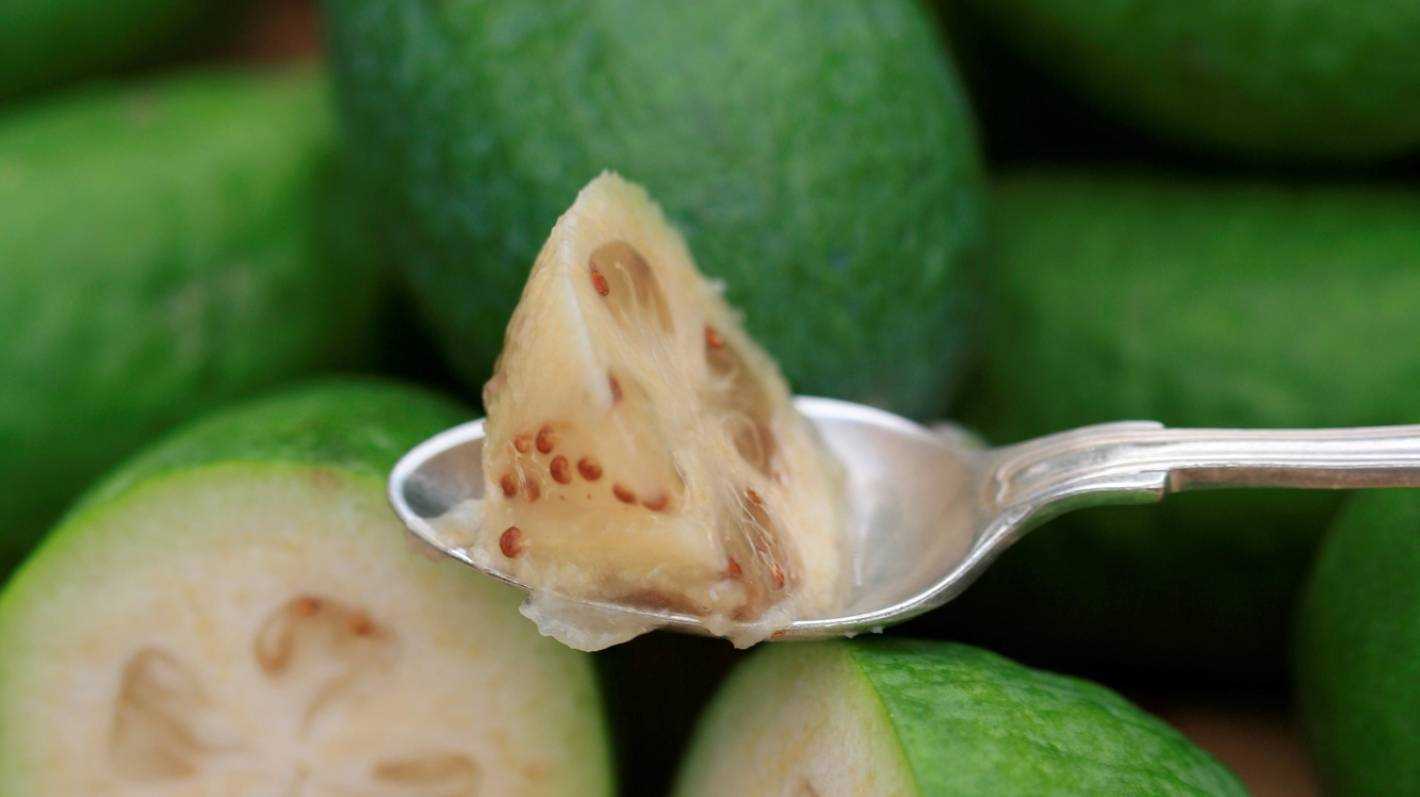
Feijoa trees benefit from regular fertilization to provide them with essential nutrients. Here are some recommendations for fertilizing feijoa trees:
- Apply a balanced, slow-release fertilizer in early spring or late winter before new growth begins.
- Use a fertilizer with an N-P-K ratio of 8-8-8 or similar.
- Spread the fertilizer evenly around the drip line of the tree.
- Avoid applying fertilizer directly to the trunk as it can cause damage.
- Water the tree thoroughly after fertilizing to help the nutrients penetrate the soil.
It is important to monitor the plant’s response to watering and fertilization and make adjustments as needed. Maintaining a consistent watering and fertilizing schedule will help promote the health and productivity of feijoa trees.
Pruning Feijoa Trees: Best Practices
Pruning feijoa trees is a crucial part of their overall care and maintenance. Proper pruning helps to promote healthy growth, maintain the desired shape, and improve fruit production. Here are some best practices for pruning feijoa trees:
1. Timing
Pruning is best done during the late winter or early spring before new growth begins. This allows the tree to heal quickly and minimize stress.
2. Tools
Use sharp and clean pruning tools to make clean cuts and prevent the spread of diseases. Good tools for pruning feijoa trees include hand pruners, loppers, and pruning saws.
3. Removing Dead and Diseased Wood
Start by removing any dead or diseased wood. This helps to improve air circulation and prevent the spread of pathogens. Cut back to healthy tissue, making a clean cut just outside the branch collar.
4. Thinning
Thin out the branches by selectively removing crowded or crossing branches. This helps to create an open structure, allowing light to penetrate the tree and promote better fruit production. Aim to remove no more than 20% of the tree’s canopy in a single pruning session.
5. Shaping
Feijoa trees can be trained into various shapes, including a single-trunk, multi-trunk, or espalier form. Prune accordingly to achieve the desired shape, taking care to maintain a balanced structure.
6. Pruning Young Trees
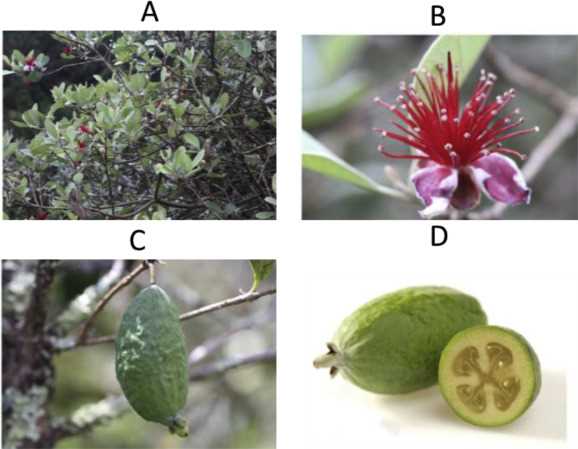
For young feijoa trees, focus on shaping and establishing a strong framework. Remove any competing branches or side shoots to encourage a central leader and well-spaced scaffold branches.
7. Regular Maintenance Pruning
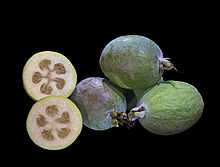
Perform regular maintenance pruning to keep the tree in good health. This includes removing any suckers, water sprouts, or unwanted growth that may emerge throughout the growing season.
8. Renovation Pruning
If the feijoa tree has been neglected or has overgrown, renovation pruning can be done to rejuvenate it. This involves removing old, unproductive wood and thinning out overcrowded branches over several years.
9. Disinfection
After each pruning cut, disinfect the pruning tools to prevent the spread of diseases. Wiping the blades with rubbing alcohol or a mixture of bleach and water is an effective way to disinfect them.
By following these best practices, you can ensure that your feijoa trees remain healthy, productive, and aesthetically pleasing. Remember to always step back and assess the overall shape and balance of the tree while pruning.
Health Benefits of Feijoa
Feijoa is a fruit that not only boasts a unique taste but also offers several health benefits. Here are some of the health benefits of feijoa:
1. High in Vitamin C
Feijoa is an excellent source of vitamin C, which is known for its immune-boosting properties. Consuming feijoa can help fortify your immune system, protect against common illnesses, and promote overall well-being.
2. Rich in Dietary Fiber
Feijoa is a good source of dietary fiber, which aids in digestion and promotes a healthy digestive system. Including feijoa in your diet can help prevent constipation, regulate bowel movements, and maintain a healthy weight.
3. Packed with Antioxidants
Feijoa is rich in antioxidants that help protect your body from free radicals, which are unstable molecules that can damage cells and contribute to aging and various diseases. Antioxidants play a crucial role in preserving overall health and reducing the risk of chronic conditions like heart disease and cancer.
4. Supports Cardiovascular Health
Feijoa contains several nutrients, such as potassium and magnesium, that are beneficial for heart health. Potassium helps regulate blood pressure, while magnesium improves blood circulation and reduces the risk of cardiovascular diseases.
5. Boosts Brain Function
Feijoa is a good source of several nutrients, including vitamin B6, which plays a vital role in brain development and function. Consuming feijoa can help enhance cognitive function, memory, and overall brain health.
6. Supports Weight Management
Feijoa is a low-calorie fruit that can be included in a balanced diet for weight management. Its high fiber content helps you feel fuller for longer, reducing the chances of overeating and aiding weight loss efforts.
7. Good for Eye Health
Feijoa is rich in antioxidants, such as vitamin C and vitamin E, along with other beneficial compounds like zeaxanthin and lutein. These nutrients contribute to eye health by reducing the risk of age-related macular degeneration and improving overall vision.
Overall, feijoa is a nutritious fruit that offers a range of health benefits. Adding this fruit to your diet can help improve your immune system, support digestion, protect against chronic diseases, and promote overall well-being.
Feijoa: Packed with Vitamins and Antioxidants
Feijoa is a delicious fruit that is not only tasty but also highly nutritious. It is packed with vitamins and antioxidants, making it a great addition to a healthy diet.
Vitamins
Feijoa is rich in vitamin C, which is essential for the immune system and helps protect against colds and flu. Just 100 grams of feijoa provides about 80% of the recommended daily intake of vitamin C.
In addition to vitamin C, feijoa also contains vitamins A and E. Vitamin A is important for healthy vision and skin, while vitamin E is a powerful antioxidant that helps protect cells from damage.
Antioxidants
Feijoa is a rich source of antioxidants, which help fight free radicals in the body that can cause cellular damage and lead to various diseases. The antioxidants in feijoa include flavonoids, phenolic compounds, and anthocyanins.
These antioxidants not only protect the body from oxidative stress but also have anti-inflammatory properties, which can help reduce the risk of chronic diseases such as heart disease and cancer.
Other Nutrients
In addition to vitamins and antioxidants, feijoa also contains other important nutrients. It is a good source of dietary fiber, which is important for digestive health and can help prevent constipation.
Feijoa also provides minerals such as potassium, magnesium, and manganese, which are essential for a healthy body and contribute to various bodily functions.
Overall, feijoa is a nutrient-dense fruit that offers a wide range of health benefits. Whether eaten on its own or added to salads, smoothies, or desserts, feijoa is a delicious and nutritious choice.
Q&A:
What is feijoa?
Feijoa is a fruit native to South America, particularly Brazil, Uruguay, and Argentina. It is also known as pineapple guava or guavasteen.
How do you grow feijoa?
To grow feijoa, you need a sunny location with well-drained soil. It is a hardy plant that can tolerate a wide range of soil conditions. Plant the feijoa seed or purchase a young feijoa plant from a nursery and transplant it into your garden. Water it regularly and prune as needed to maintain its shape.
What are the health benefits of feijoa?
Feijoa is rich in vitamin C, dietary fiber, and antioxidants. It has been found to boost the immune system, improve digestion, and promote healthy skin. Feijoa also contains potassium, magnesium, and calcium, which are essential for maintaining healthy bones and muscles.
Can you eat feijoa skin?
Yes, you can eat feijoa skin. The skin is thin and edible, and it adds a slightly tart flavor to the fruit. However, some people prefer to peel the fruit before eating it.
When is the best time to harvest feijoa?
The best time to harvest feijoa is when the fruit falls off easily from the tree or when it reaches a yellow-green color. Ripe feijoa should have a pleasant fragrance and give slightly when pressed.
What are some popular recipes that use feijoa?
Feijoa can be used in a variety of recipes, including smoothies, jams, jellies, desserts, and even savory dishes. Some popular feijoa recipes include feijoa crumble, feijoa cheesecake, and feijoa chutney.
Can I grow feijoa in a container?
Yes, feijoa can be grown in a container. Choose a large pot with good drainage and use a well-draining potting mix. Make sure to place the container in a sunny location and water the plant regularly.
Video:
TOP 5 Anti-Aging Fruits You Should Be Eating Every Day!
https://youtube.com/watch?v=pmePb6QeG1w







